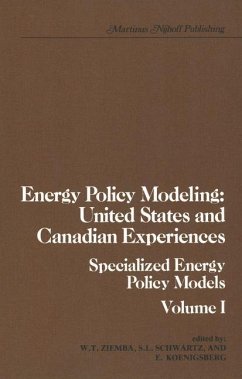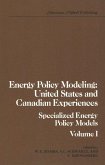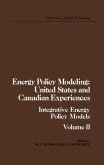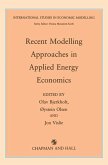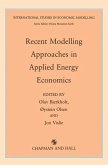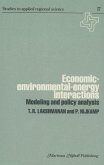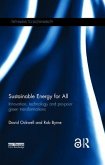W. T. Ziemba / S.L. Schwartz (Hgg.)Volume I Specialized Energy Policy Models
Energy Policy Modeling: United States and Canadian Experiences
Volume I Specialized Energy Policy Models
Herausgegeben:Ziemba, William T.; Schwartz, S. L.
W. T. Ziemba / S.L. Schwartz (Hgg.)Volume I Specialized Energy Policy Models
Energy Policy Modeling: United States and Canadian Experiences
Volume I Specialized Energy Policy Models
Herausgegeben:Ziemba, William T.; Schwartz, S. L.
- Gebundenes Buch
- Merkliste
- Auf die Merkliste
- Bewerten Bewerten
- Teilen
- Produkt teilen
- Produkterinnerung
- Produkterinnerung
Alex Cowie As the twentieth century draws to a close, one of our greatest problems is the availability of energy. One way to study the energy problem is to resolve it into four areas; energy demand, energy sources, transportation of energy from sources to demand centers, and the optimal allocation of energy forms to demands. Each of these areas is extremely complex by itself. When efforts are made to tie them together, for example, to produce a National Policy, the complexities are compounded. Another way to study the energy problem, because of its political and so cial consequences, is to…mehr
Andere Kunden interessierten sich auch für
![Energy Policy Modeling: United States and Canadian Experiences Energy Policy Modeling: United States and Canadian Experiences]() Energy Policy Modeling: United States and Canadian Experiences121,99 €
Energy Policy Modeling: United States and Canadian Experiences121,99 €![Energy Policy Modeling: United States and Canadian Experiences Energy Policy Modeling: United States and Canadian Experiences]() Energy Policy Modeling: United States and Canadian Experiences121,99 €
Energy Policy Modeling: United States and Canadian Experiences121,99 €![Recent Modelling Approaches in Applied Energy Economics Recent Modelling Approaches in Applied Energy Economics]() O. BjerkholtRecent Modelling Approaches in Applied Energy Economics240,99 €
O. BjerkholtRecent Modelling Approaches in Applied Energy Economics240,99 €![Recent Modelling Approaches in Applied Energy Economics Recent Modelling Approaches in Applied Energy Economics]() Olav BjerkholtRecent Modelling Approaches in Applied Energy Economics161,99 €
Olav BjerkholtRecent Modelling Approaches in Applied Energy Economics161,99 €![Economic¿Environmental¿Energy Interactions Economic¿Environmental¿Energy Interactions]() T.R. Lakshmanan (Hrsg.)Economic¿Environmental¿Energy Interactions121,99 €
T.R. Lakshmanan (Hrsg.)Economic¿Environmental¿Energy Interactions121,99 €![Biodiversity Conservation Biodiversity Conservation]() Charles A. Perrings / Karl-Göran Mäler / C. Folke / C.S. Holling / Beng-Owe Jansson (Hgg.)Biodiversity Conservation121,99 €
Charles A. Perrings / Karl-Göran Mäler / C. Folke / C.S. Holling / Beng-Owe Jansson (Hgg.)Biodiversity Conservation121,99 €![Sustainable Energy for All Sustainable Energy for All]() David OckwellSustainable Energy for All197,99 €
David OckwellSustainable Energy for All197,99 €-
-
-
Alex Cowie As the twentieth century draws to a close, one of our greatest problems is the availability of energy. One way to study the energy problem is to resolve it into four areas; energy demand, energy sources, transportation of energy from sources to demand centers, and the optimal allocation of energy forms to demands. Each of these areas is extremely complex by itself. When efforts are made to tie them together, for example, to produce a National Policy, the complexities are compounded. Another way to study the energy problem, because of its political and so cial consequences, is to resolve it into geographical areas. Individual prov inces of Canada or states of the United States will have their concerns about energy within their geographical boundaries. As producer, consumer, or both, each wants to ensure an energy development program which will work to the maximum benefit of its citizens. Similarly, countries endeavor to pro tect their citizens and undertake energy policies that will assure either a con tinuation of the existing quality of life or - particularly in the case of "Third World" countries - a marked improvement in quality of life. These competing and conflicting goals call for a study which encompasses the whole world. Again, complexity is piled upon complexity. If the prob lem is not yet sufficiently complex, there is an equally complex question of the effect of energy production and use on the ecology.
Hinweis: Dieser Artikel kann nur an eine deutsche Lieferadresse ausgeliefert werden.
Hinweis: Dieser Artikel kann nur an eine deutsche Lieferadresse ausgeliefert werden.
Produktdetails
- Produktdetails
- Verlag: Springer / Springer Netherlands
- Artikelnr. des Verlages: 978-0-89838-031-6
- 1980.
- Seitenzahl: 420
- Erscheinungstermin: 30. April 1980
- Englisch
- Abmessung: 241mm x 160mm x 28mm
- Gewicht: 767g
- ISBN-13: 9780898380316
- ISBN-10: 0898380316
- Artikelnr.: 21218381
- Herstellerkennzeichnung Die Herstellerinformationen sind derzeit nicht verfügbar.
- Verlag: Springer / Springer Netherlands
- Artikelnr. des Verlages: 978-0-89838-031-6
- 1980.
- Seitenzahl: 420
- Erscheinungstermin: 30. April 1980
- Englisch
- Abmessung: 241mm x 160mm x 28mm
- Gewicht: 767g
- ISBN-13: 9780898380316
- ISBN-10: 0898380316
- Artikelnr.: 21218381
- Herstellerkennzeichnung Die Herstellerinformationen sind derzeit nicht verfügbar.
I Energy Demand Modeling.- References.- 1 The Energy Demand Forecasting System of the National Energy Board.- 1.1 Overview of the Model.- 1.2 Recent Research in the Residential, Commercial, and Industrial Sectors.- 1.3 Applications of the Model.- References.- 2 A Policy Model of Canadian Interfuel Substitution Demands.- 2.1 Introduction.- 2.2 Approach.- 2.3 Model Specifications.- 2.4 Econometric Considerations.- 2.5 Estimation Results.- 2.6 Conclusions.- References.- 3 Inflationary Expectations and the Demand for Capital, Labor, and Energy in Canadian Manufacturing Industries.- 3.1 Introduction.- 3.2 Incorporation of Inflationary Expectations.- 3.3 Methodology and Data.- 3.4 Results and Policy Implications.- 3.5 Conclusions.- References.- 4 The Derived Demand for Energy in the Presence of Supply Constraints.- 4.1 Introduction.- 4.2 A Model of Producer Behavior Subject to Supply Constraints.- 4.3 An Estimated Production Structure for Canadian Manufacturing.- 4.4 Constrained Demand and Two-Stage Translog Model.- 4.5 An Empirical Example.- 4.6 Further Extensions and Applications.- References.- 5 The Residential Demand for Electric Energy and Natural Gas in Canada.- 5.1 Introduction.- 5.2 The Model.- 5.3 Estimation.- 5.4 Results and Interpretation.- 5.5 Conclusions.- References.- 6 An Econometric Model of Alberta Electricity Demand.- 6.1 Introduction.- 6.2 Electricity Prices.- 6.3 Residential Sector.- 6.4 Commercial Sector.- 6.5 Industrial Sector.- 6.6 Conclusion.- References.- 7 A Model for Forecasting Passenger Car Gasoline Demand.- 7.1 Introduction.- 7.2 New Car Sales.- 7.3 Market Share Equations.- 7.4 Probabilities of Survival.- 7.5 Estimation of Mileage Traveled.- 7.6 Fuel Economies and Urban/Nonurban Travel Split.- 7.7 Applications of the Model.- References.- II Energy Supply Modeling.- References.- 8 Choosing the Overall Size of the Strategic Petroleum Reserve.- 8.1 Introduction and Background.- 8.2 The Limitations of Cost-Benefit Analysis.- 8.3 A Parametric Bimatrix Game.- 8.4 Reserve Size and Embargo Length.- 8.5 Some Numerical Results.- 8.6 Conclusions.- 8.7 Post Scriptum.- References.- 9 Economic Modeling of Energy Supply from Burning Wood Wastes at British Columbia Pulp and Paper Mills.- 9.1 Introduction.- 9.2 Description of the Model.- 9.3 Evaluating the Economics of Fossil Fuel Replacement.- 9.4 Evaluating the Economics of Electricity Generation.- 9.5 Energy Pricing and Wood Waste Supply.- 9.6 Conclusions.- References.- 10 Simulation of Tar Sands Mining Operations.- 10.1 Introduction.- 10.2 Historical Background.- 10.3 Technical Background.- 10.4 Simulation Effort.- 10.5 Selection of Mining Equipment.- 10.6 Appendix A.- 10.7 Appendix B.- 10.8 Addendum (October 30, 1978).- 11 A Model of Energy Supply from Western Canada.- 11.1 Introduction.- 11.2 Structure of the Model.- 11.3 Illustrative Model Solutions and Comparative Statics.- 11.4 Concluding Remarks.- References.- 12 The Incorporation of New Technologies in Energy Supply Estimation.- 12.1 Introduction.- 12.2 Scope of the Approach.- 12.3 The Model.- 12.4 Observations on the Model.- References.- III Coal and Transportation Modeling.- References.- 13 Modeling U.S. Coal Supply and Demand.- 13.1 Introduction.- 13.2 Coal in Transition Project.- 13.3 Coal Development Scenarios.- 13.4 Model Results.- 13.5 Assessment of Energy Infrastructure Requirements.- References.- 14 The Transport of Energy by Rail.- 14.1 Introduction.- 14.2 Growth of Rail Capacity.- 14.3 Present Activities at CN.- 14.4 Concluding Remarks.- 15 Coal Slurry Pipelines: A Technology Assessment.- 15.1 Technology Assessment and the Role of the OTA.- 15.2 The Slurry Pipelines Study: An Overview.- 15.3 Modeling Techniques Used.- 15.4 The Results.- References.- 16 Costing the Movement of Western Canadian Coal to Thunder Bay: An Incremental Approach.- 16.1 Introduction.- 16.2 Systems Analysis.- 16.3 Tariff Schedules and Analysis.- 16.4 Policy Implications.- References.- 17 Simulation Modeling of Coal Terminals.- 17.1 Justification for Simulation Modeling.- 17.2 Modeling Considerations at Coal Terminals.- 17.3 Case Study: Richards Bay, South Africa.- 17.4 Conclusion.- 18 A Short Run Model of the World Petroleum Network Based on Decomposition.- 18.1 Introduction.- 18.2 Overall Description of Martinet.- 18.3 Computational Improvements.- Reference.- IV The Problems and Interactions of Energy, Environment, and Conservation.- References.- 19 Projections of Solar Energy Utilization: A Guide to Federal Planning.- 19.1 Introduction.- 19.2 Capturing the Dynamics of the Solar Transition: The Spurr Model.- 19.3 The Buildings Components: An Example.- 19.4 Summary of Projections of Solar Energy Utilization.- References.- 20 Modeling the Economic and Environmental Impacts of Alternative Electric Utility Futures.- 20.1 Introduction.- 20.2 The Utility Simulation Model.- 20.3 Applications of the Modeling and its Results.- 20.4 Usefulness of the Integrated Approach to Modeling.- References.- 21 Systems Approach to Assessing Electricity Conservation Initiatives.- 21.1 Introduction.- 21.2 The Rate Simulation Model.- 21.3 Concepts of Technological Modeling.- 21.4 Results of Applying the Model to Alternative Rate Structures.- References.- 22 Saving Half of California's Energy and Peak Power in Buildings and Appliances.- 22.1 Overview.- 22.2 Case Studies: Optimized Buildings and Appliances.- References.
I Energy Demand Modeling.- References.- 1 The Energy Demand Forecasting System of the National Energy Board.- 1.1 Overview of the Model.- 1.2 Recent Research in the Residential, Commercial, and Industrial Sectors.- 1.3 Applications of the Model.- References.- 2 A Policy Model of Canadian Interfuel Substitution Demands.- 2.1 Introduction.- 2.2 Approach.- 2.3 Model Specifications.- 2.4 Econometric Considerations.- 2.5 Estimation Results.- 2.6 Conclusions.- References.- 3 Inflationary Expectations and the Demand for Capital, Labor, and Energy in Canadian Manufacturing Industries.- 3.1 Introduction.- 3.2 Incorporation of Inflationary Expectations.- 3.3 Methodology and Data.- 3.4 Results and Policy Implications.- 3.5 Conclusions.- References.- 4 The Derived Demand for Energy in the Presence of Supply Constraints.- 4.1 Introduction.- 4.2 A Model of Producer Behavior Subject to Supply Constraints.- 4.3 An Estimated Production Structure for Canadian Manufacturing.- 4.4 Constrained Demand and Two-Stage Translog Model.- 4.5 An Empirical Example.- 4.6 Further Extensions and Applications.- References.- 5 The Residential Demand for Electric Energy and Natural Gas in Canada.- 5.1 Introduction.- 5.2 The Model.- 5.3 Estimation.- 5.4 Results and Interpretation.- 5.5 Conclusions.- References.- 6 An Econometric Model of Alberta Electricity Demand.- 6.1 Introduction.- 6.2 Electricity Prices.- 6.3 Residential Sector.- 6.4 Commercial Sector.- 6.5 Industrial Sector.- 6.6 Conclusion.- References.- 7 A Model for Forecasting Passenger Car Gasoline Demand.- 7.1 Introduction.- 7.2 New Car Sales.- 7.3 Market Share Equations.- 7.4 Probabilities of Survival.- 7.5 Estimation of Mileage Traveled.- 7.6 Fuel Economies and Urban/Nonurban Travel Split.- 7.7 Applications of the Model.- References.- II Energy Supply Modeling.- References.- 8 Choosing the Overall Size of the Strategic Petroleum Reserve.- 8.1 Introduction and Background.- 8.2 The Limitations of Cost-Benefit Analysis.- 8.3 A Parametric Bimatrix Game.- 8.4 Reserve Size and Embargo Length.- 8.5 Some Numerical Results.- 8.6 Conclusions.- 8.7 Post Scriptum.- References.- 9 Economic Modeling of Energy Supply from Burning Wood Wastes at British Columbia Pulp and Paper Mills.- 9.1 Introduction.- 9.2 Description of the Model.- 9.3 Evaluating the Economics of Fossil Fuel Replacement.- 9.4 Evaluating the Economics of Electricity Generation.- 9.5 Energy Pricing and Wood Waste Supply.- 9.6 Conclusions.- References.- 10 Simulation of Tar Sands Mining Operations.- 10.1 Introduction.- 10.2 Historical Background.- 10.3 Technical Background.- 10.4 Simulation Effort.- 10.5 Selection of Mining Equipment.- 10.6 Appendix A.- 10.7 Appendix B.- 10.8 Addendum (October 30, 1978).- 11 A Model of Energy Supply from Western Canada.- 11.1 Introduction.- 11.2 Structure of the Model.- 11.3 Illustrative Model Solutions and Comparative Statics.- 11.4 Concluding Remarks.- References.- 12 The Incorporation of New Technologies in Energy Supply Estimation.- 12.1 Introduction.- 12.2 Scope of the Approach.- 12.3 The Model.- 12.4 Observations on the Model.- References.- III Coal and Transportation Modeling.- References.- 13 Modeling U.S. Coal Supply and Demand.- 13.1 Introduction.- 13.2 Coal in Transition Project.- 13.3 Coal Development Scenarios.- 13.4 Model Results.- 13.5 Assessment of Energy Infrastructure Requirements.- References.- 14 The Transport of Energy by Rail.- 14.1 Introduction.- 14.2 Growth of Rail Capacity.- 14.3 Present Activities at CN.- 14.4 Concluding Remarks.- 15 Coal Slurry Pipelines: A Technology Assessment.- 15.1 Technology Assessment and the Role of the OTA.- 15.2 The Slurry Pipelines Study: An Overview.- 15.3 Modeling Techniques Used.- 15.4 The Results.- References.- 16 Costing the Movement of Western Canadian Coal to Thunder Bay: An Incremental Approach.- 16.1 Introduction.- 16.2 Systems Analysis.- 16.3 Tariff Schedules and Analysis.- 16.4 Policy Implications.- References.- 17 Simulation Modeling of Coal Terminals.- 17.1 Justification for Simulation Modeling.- 17.2 Modeling Considerations at Coal Terminals.- 17.3 Case Study: Richards Bay, South Africa.- 17.4 Conclusion.- 18 A Short Run Model of the World Petroleum Network Based on Decomposition.- 18.1 Introduction.- 18.2 Overall Description of Martinet.- 18.3 Computational Improvements.- Reference.- IV The Problems and Interactions of Energy, Environment, and Conservation.- References.- 19 Projections of Solar Energy Utilization: A Guide to Federal Planning.- 19.1 Introduction.- 19.2 Capturing the Dynamics of the Solar Transition: The Spurr Model.- 19.3 The Buildings Components: An Example.- 19.4 Summary of Projections of Solar Energy Utilization.- References.- 20 Modeling the Economic and Environmental Impacts of Alternative Electric Utility Futures.- 20.1 Introduction.- 20.2 The Utility Simulation Model.- 20.3 Applications of the Modeling and its Results.- 20.4 Usefulness of the Integrated Approach to Modeling.- References.- 21 Systems Approach to Assessing Electricity Conservation Initiatives.- 21.1 Introduction.- 21.2 The Rate Simulation Model.- 21.3 Concepts of Technological Modeling.- 21.4 Results of Applying the Model to Alternative Rate Structures.- References.- 22 Saving Half of California's Energy and Peak Power in Buildings and Appliances.- 22.1 Overview.- 22.2 Case Studies: Optimized Buildings and Appliances.- References.

